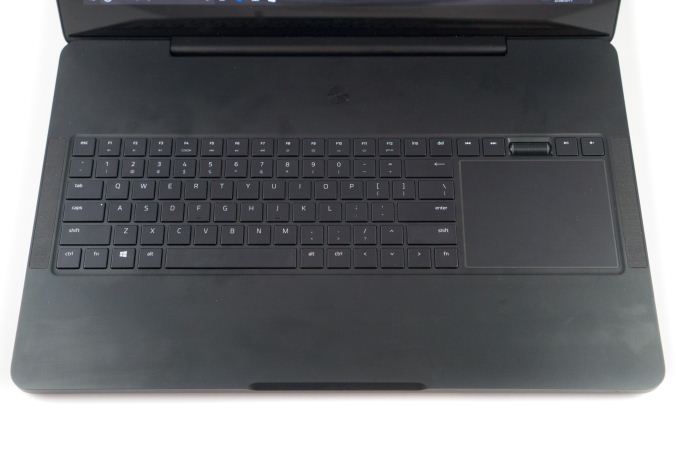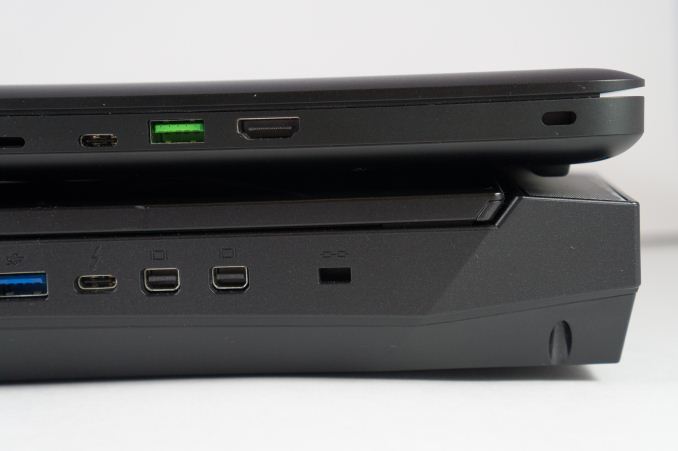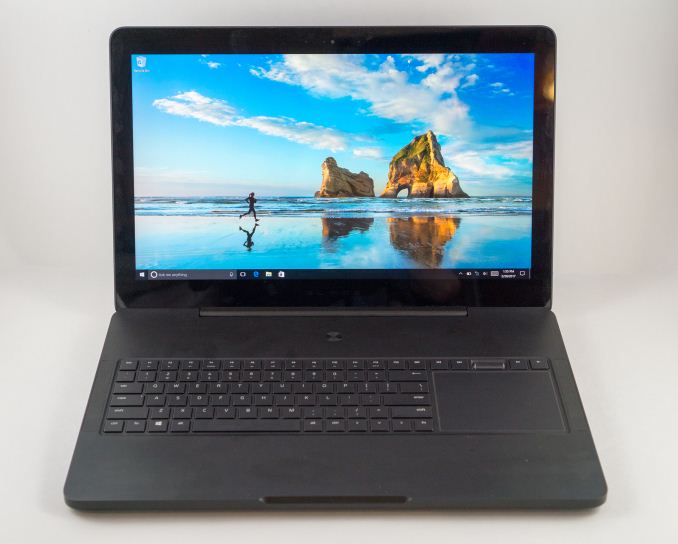The 2016 Razer Blade Pro Review
by Brandon Chester on March 6, 2017 8:00 AM EST- Posted in
- Laptops
- Razer
- Razer Blade Pro
Final Words
With the 2016 Blade Pro, Razer's goal has been to create the most powerful gaming machine possible in a form factor that is much smaller and lighter than your typical desktop replacement machine. That being said, the Blade Pro is not the kind of laptop that you'll throw in a backpack and carry around for the entire day, and despite its designation, it's not really something you'll want to use on your lap. With a mass of 3.54kg, and a large 17.3" display, it's more like a highly portable computer than a notebook.
The Razer Blade Pro is one of the most well-constructed laptops that I've used. The chassis is incredibly solid, and designing it out of a single block of aluminum allows for an enclosure without visible seams. I find the black finish quite striking as well, and it really stands out among a sea of grey plastic laptops.
The design of the laptop is a mixed bag for me. I think the keyboard and trackpad layout is interesting, and the ergonomics of it are actually quite nice. There are also some interesting design accents like the raised portions on the left and right side of the top cover. I also find some aspects of the design to be distasteful, such as the green glowing Razer logo on the back, the keyboard key font, the green accents on the USB ports, and the Chroma backlighting, although admittedly that last one can be turned off or toned down to a simple static white color. I would love a version with a totally black finish, complete with a black razer logo without the LEDs, but I understand that the green and black color scheme is closely tied with Razer's brand.
The general performance of the Blade Pro is in line with existing Core i7-6700HQ machines. I don't mean to keep bringing up the same point over and over, but with the Blade Pro being a very expensive premium machine, Razer really should have used the Core i7-6920HQ to give themselves an edge over the competition. While the Blade Pro is vastly more portable than DTR machines like the Clevo P870DM2, it still has to compete with them in the eyes of consumers, and those machines are thick and large enough to accomodate Intel's desktop CPUs. Using the Core i7-6920HQ would have helped to close the gap, and made the Blade Pro's general performance even more impressive.
Razer Blade Pro on top of a Clevo DTR
As for GPU-bound workloads, there's very few other laptops that can compete with the Blade Pro. Unless you're willing to go with a DTR, which will be twice as thick and nearly twice as heavy, the Blade Pro is the fastest laptop you'll find. Much of the gap in gaming performance actually comes from the difference in CPUs, and during my testing I observed essentially no throttling of the GPU clocks even with a long-running workload. This is a really impressive feat on the part of Razer and NVIDIA. I still find it amazing that a laptop the size of the Blade Pro greatly surpasses the performance of desktop computers with NVIDIA's GTX 980, which was the flagship card of the Maxwell generation. We've certainly come a long way from the days where the best laptop GPUs were basically equivalent to the mid-range desktop parts, and the Blade Pro is perhaps the ultimate demonstration of how far we've come.
The Blade Pro's display is not as good as I expected it to be, and it really kills the possibility of using the Blade Pro as a mobile workstation for anyone who does color-critical work. Targeting Adobe RGB without an sRGB color mode under Windows is just unacceptable, end of story. However, even if Windows did have end-to-end color management throughout all its frameworks and applications, that wouldn't change the fact that the calibration relative to Adobe RGB is not very good either. To do any sort of color-critical work, even in a color-managed application, you need to completely redo the display calibration. Fixing these problems would elevate the Blade Pro from a gaming machine to an incredible portable workstation for video editing and visual design, and it wouldn't even be very difficult. We're now living in a world where you can get perfectly calibrated displays in $600 tablets, so there's no excuse for a $3699 laptop to suffer from these issues.
As for battery life, I would say it's perfectly acceptable and actually more than I expected. Razer cannot wish away the realities of the world. A machine with this performance is going to consume a given amount of power even when it's not doing much, and the only potential optimization would be to get rid of G-SYNC so Optimus could be used, but with the goal of a gaming laptop in mind that would be a detrimental product change overall. I will say that using two separate SSDs has a power cost, although I don't think it's of much significance compared to the CPU, GPU, and display. Razer is also stuck with the battery capacity of 99Wh, unless they want to sell a laptop that you can't bring on an airplane. I would love to have a thin gaming laptop that manages to last ten hours on its battery at max performance, but as far as realistic expectations go, close to four hours of battery life for general tasks at 200 nits is quite good for a 17-inch gaming laptop.
The 2016 Razer Blade Pro is a great gaming laptop. I certainly wish I could afford one for myself. My life right now is characterized by frequent moving due to work and university, and something like the Blade Pro would allow me to bring an incredibly powerful machine with me wherever I go. While the Blade Pro fulfills its role as a high performance gaming machine, it did let me down as a mobile workstation. The issues with the display calibration and lack of an sRGB color mode make it unusable for much of the work I do. On top of that, product decisions like using two SSDs in RAID0, using Intel's slowest Core i7 H series quad core part, and using Killer's networking chips just don't make sense. With the SSDs and the networking, Razer is paying more money for a worse outcome just because it's marketable to gamers, but with the CPU they didn't spend the extra money on something that would have a real impact on performance. This isn't just a difference of opinion on what makes a good product; the choices that were made are objectively and demonstrably worse than the alternative.
In the end, the Razer Blade Pro is a powerful, portable gaming machine, but I feel that it has so much potential that can't be unlocked because of a few questionable product decisions. Most of the issues I've highlighted would be really easy to address, and it would allow the Blade Pro to be so much more than just a gaming laptop. I really like the Razer Blade Pro, and I really want one. Unfortunately, if I'm spending that much money on a laptop, I need it to truly be a no-compromises machine. As someone who needs a computer for more than playing games, it just doesn't hit that mark.













57 Comments
View All Comments
Eden-K121D - Monday, March 6, 2017 - link
Who'll buy this?Ninhalem - Monday, March 6, 2017 - link
From the article: "The 2016 Razer Blade Pro is a great gaming laptop. I certainly wish I could afford one for myself. My life right now is characterized by frequent moving due to work and university, and something like the Blade Pro would allow me to bring an incredibly powerful machine with me wherever I go. While the Blade Pro fulfills its role as a high performance gaming machine, it did let me down as a mobile workstation."The last sentence feels like an unintended scenario for this laptop. Mobile workstation to me says you need to do activities like CAD and/or purely business work, and requires a CAD card instead of the mainstream variant. This laptop's intended audience clearly isn't the business world.
fanofanand - Monday, March 6, 2017 - link
No $4,000 laptop should be usable ONLY for gaming, any other laptop in this price range is a jack of all trades sans military laptops.Brandon Chester - Monday, March 6, 2017 - link
Yeah that was my point. I'm actually willing to shell out $3700 on a laptop if it can replace every other computer in my life. If it can only replace a gaming machine then it's going to be limited to the niche of users who can afford paying that much just to bring their games around with them.akdj - Tuesday, March 14, 2017 - link
I'm with ya Brandon - always have been, as my laptop pays my mortgage, son's tuition, and wife's car payment;)As an OS X/macOS user over the last decade, their last half year 'computationally, has excited me as much as a three hundred mile road trip to grandpa and grandma's in the station wagon as a kid. And I can't be totally sure, but I think I might not be their 'audience' any longer...kinda feel unwanted after a pair of 17" 2008/2011 & two 15s in the Intel era, 2012 and 2015. Plenty between my '83 IIe and current 2015 15"
... I was very excited for your review
Needless to say, I'm shocked at the results (even in comparison w/their small 14" model you reviewed, as the objective 'scores and analysis' are in the charts with both machines represented!)
Oh well, always a compromise
DanNeely - Monday, March 6, 2017 - link
From a few sentences later in the article it's clear that he's talking about a image/video editing workstation not a CAD box; for the former only the screen is really holding it back.QuinRiva - Monday, March 6, 2017 - link
Mid level technical professionals... The business is buying it, so the price is pretty insignificant compared to salary and overheads. Sure, most of my workload is offloaded to a DB or compute node somewhere, but loads of prototyping and presentation workload is done on the laptop/client side.Quadcore is essential just to run things like Excel/Tableau, and a decent graphics card is useful for Illustrator, or running neural nets; or spending a bit of time relaxing playing a game on an international business trip.
And if they want "pro" buy-in, it has to look like a professional tool - I can't turn up to a client meeting with a flashing garish "gaming laptop". The XPS 15 is a pretty good compromise on this front, it's just a pity it was limited to GTX 960M.
milkod2001 - Thursday, March 9, 2017 - link
Rich kidz who play games and content creators who think that their web sized images will somehow load on this machine faster...Price is ridiculous, screen, GPU & CPU should not cost more than 1000, the rest 500 leaving 500 margin for Razor if sold at realistic $2000 but no this costs $3699. What a joke.
fanofanand - Monday, March 13, 2017 - link
That GPU alone was $700 in the desktop form up until a couple weeks ago, and the "recommended" price on that CPU is $378. I know Razer isn't paying retail on these things but if you believe $1,000 for the screen, CPU and CPU "should not cost more than 1000" then I think you are unaware of component prices. Yes this thing has huge margins, yes it's ridiculously overpriced, but I think your numbers are pure fantasy.digiguy - Monday, March 6, 2017 - link
One negative aspect seems to be unanimously mentioned by all reviewers: the keyboard is crap. Which, for a laptop, is a big negative.